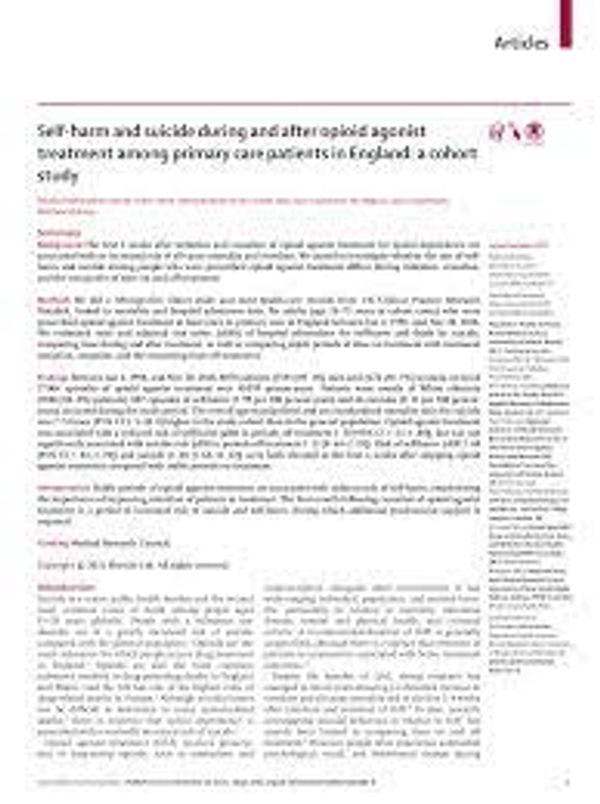Self-harm and suicide during and after opioid agonist treatment among primary care patients in England: a cohort study
By Prianka Padmanathan MSc, Harriet Forbes PhD, Maria Theresa Redaniel PhD, Prof David Gunnell FMed Sci, Dan Lewer MSc, Prof Paul Moran MD, Ben Watson MD, Prof Louisa Degenhardt PhD, Prof Matthew Hickman PhD
Background
The first 4 weeks after initiation and cessation of opioid agonist treatment for opioid dependence are associated with an increased risk of all-cause mortality and overdose. We aimed to investigate whether the rate of self-harm and suicide among people who were prescribed opioid agonist treatment differs during initiation, cessation, and the remainder of time on and off treatment.
Methods
We did a retrospective cohort study and used health-care records from UK Clinical Practice Research Datalink, linked to mortality and hospital admission data, for adults (age 18–75 years at cohort entry) who were prescribed opioid agonist treatment at least once in primary care in England between Jan 2, 1998, and Nov 30, 2018. We estimated rates and adjusted risk ratios (aRRs) of hospital admissions for self-harm and death by suicide, comparing time during and after treatment, as well as comparing stable periods of time on treatment with treatment initiation, cessation, and the remaining time off treatment.
Findings
Between Jan 2, 1998, and Nov 30, 2018, 8070 patients (5594 [69·3%] men and 2476 [30·7%] women) received 17 004 episodes of opioid agonist treatment over 40 599 person-years. Patients were mostly of White ethnicity (7006 [86·8%] patients). 807 episodes of self-harm (1·99 per 100 person-years) and 46 suicides (0·11 per 100 person-years) occurred during the study period. The overall age-standardised and sex-standardised mortality ratio for suicide was 7·5 times (95% CI 5·5–10·0) higher in the study cohort than in the general population. Opioid agonist treatment was associated with a reduced risk of self-harm (aRR in periods off treatment 1·50 [95% CI 1·21–1·88]), but was not significantly associated with suicide risk (aRR in periods off treatment 1·21 [0·64–2·28]). Risk of self-harm (aRR 2·60 [95% CI 1·83–3·70]) and suicide (4·68 [1·63–13·42]) were both elevated in the first 4 weeks after stopping opioid agonist treatment compared with stable periods on treatment.
Interpretation
Stable periods of opioid agonist treatment are associated with reduced risk of self-harm, emphasising the importance of improving retention of patients in treatment. The first month following cessation of opioid agonist treatment is a period of increased risk of suicide and self-harm, during which additional psychosocial support is required.
Click here to read the full article (restricted access).
